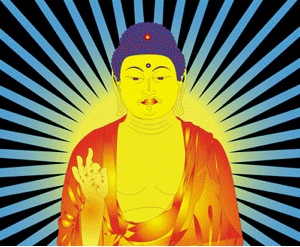
BACKGROUND:
Hozen Seki was a Japanese Jodo Shinshu (“True Pure Land”) priest who came to America in 1930, serving in Los Angeles and Arizona before founding the New York Buddhist Church in 1937. During World War II he was interned in relocation camps in Maryland, Idaho, and New Mexico. He later became a U.S. citizen.
Amida is the Buddha of Infinite Light and Life. As a bodhisattva in remote kalpas (eons) past, he made a vow not to become a buddha as long as there was even one living being who, calling upon his name in faith, failed to attain birth in his “Western Pure Land.” In that land all impediments to enlightenment would be removed and one could quickly attain liberation from suffering.
The unique logic of Pure Land Buddhism states that, since that primordial bodhisattva became Amida Buddha long ages ago, his vow to save all beings has already been fulfilled—thus, this land truly is the Pure Land. As a symbol, Amida Buddha represents a cosmic (or planetary) ecosystem in which all beings are saved already because no beings have any reality apart from Amida’s universal, compassionate embrace. Seki once told his followers, “If I believed that there were any condition [any special requirement] in Amida’s embrace, I would abandon this ministry.”
Nembutsu (lit. “to think of Buddha”) is the practice of reciting Namu Amida Butsu or Namo Omito Fo (“I take refuge in Amida”). The primary practice of all schools of Pure Land Buddhism, it can be performed as a jiriki (“self power”) practice, usually in conjunction with some form of seated meditation, or as a tariki (“other power”) practice, entrusting oneself to Amida Buddha in much the same way that people in 12 Step Recovery learn to rely upon a Higher Power.
COMMENTARY:
A monk asked Jōshū, “Does a dog have buddha nature?” Someone must have asked Seki, “Do dogs go to heaven?” The only legitimate answer is, “Why stop at dogs?”
Jōshū answers with a word meant to shatter all non-ecological concepts of salvation. Thus, today Zen monks say “Moooo” until the cows come home, annihilating every thought of a universe that “loses track” of living beings. Seki’s approach is gentler. Go ahead and say the nembutsu if you want to. Knock yourself out trying to get enlightened (or your dog into heaven). But at least try to say it out of gratitude, not lack. Otherwise, you’ve missed the point.
VERSE:
Dogs go to heaven
A little more readily
Than human beings.
When the universe says “Come!”
They return without delay.
Green Koans Case 1: Shakyamuni Touches the Earth
Green Koans Case 2: Shantideva’s Sword
Green Koans Case 3: The Great Compassionate One’s True Eye
Green Koans Case 4: One-Page Dharma
Green Koans Case 5: The Person of the Way
Green Koans Case 6: The Green Yogi
Green Koans Case 7: Rain of the Law
Green Koans Case 8: Bashō’s Last Words
Green Koans Case 9: General Stone Tiger
Green Koans Case 10: Joshu’s Oak Tree
Green Koans Case 11: A Brahman Takes a Bath
Green Koans Case 12: The Original Face
Green Koans Case 13: Seki’s Amida
Thank you for subscribing to Tricycle! As a nonprofit, we depend on readers like you to keep Buddhist teachings and practices widely available.